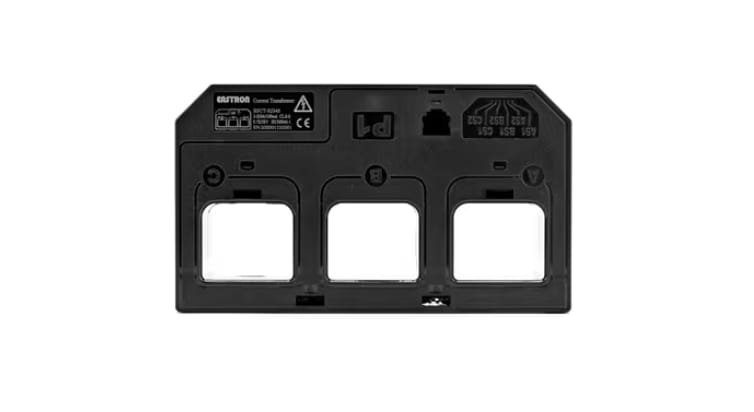The Role of Current Transformers in Power Monitoring and Management

Today, efficient energy management is critical. However, at the core of power monitoring systems, current transformers (CTs) play a vital role by measuring current flow and helping utilities and businesses track energy usage accurately. A current transformer helps manage energy consumption, optimize power usage, and prevent equipment overloads for residential, industrial, or commercial applications, ultimately contributing to a more reliable and sustainable electrical infrastructure.
What is a Current Transformer?
A current transformer is an electrical device designed to measure and monitor alternating current (AC) in power systems. The CT’s primary function is to transform high currents from the main electrical circuit into lower, manageable currents that standard metering devices can safely measure without posing a risk of damage. The current transformer then interprets the reduced current for monitoring or billing purposes.
Current transformers are widely used in various applications, from industrial factories to commercial buildings, where accurate power monitoring and management are essential. In the UK, for instance, they are an integral part of the power infrastructure, supporting both utility companies and businesses in monitoring energy usage precisely and efficiently.
CT is essential for:
· Commercial and Industrial Billing: Where energy usage is high, CTs provide accurate measurements that form the basis for billing in commercial and industrial buildings.
· Power Quality Monitoring: In industries where power quality impacts performance, CT tracks usage and helps manage demand.
· Energy Management Systems: CT integrates into energy management systems, allowing facilities to optimize energy consumption and improve efficiency.
1: Types of Current Transformers
Current transformers come in several designs, each suited to specific applications. Some common types include:
1. Window or Ring-Type CTs: This design has a hollow core, allowing the primary conductor to pass through. They’re commonly used in high-voltage applications, such as substation monitoring.
2. Bar-Type CTs: These CTs have a straight conductor as the primary winding. They are typically installed where the current to be measured is high and accurate measurement is required.
3. Wound-type CTs: These have primary and secondary windings wrapped around the core. They are ideal for measuring low currents.
2: Applications of Current Transformers
CTs’ versatility means they find applications across multiple sectors, enhancing the efficiency and safety of electrical systems.
· Utility Metering: Utility companies use CTs for accurate billing and to monitor power usage in high-voltage lines.
· Industrial Applications: They track power consumption across various machinery and equipment. This feature enables companies to manage their energy use and prevent costly downtime due to overloads.
· Commercial Buildings: Office buildings and retail spaces use CTs to measure tenant energy consumption, providing a fair basis for billing and encouraging efficient energy use.
· Renewable Energy Monitoring: CTs help monitor and manage power flow in renewable energy systems, such as solar and wind installations, ensuring consistent performance and grid stability.
How Does a Current Transformer Work?
A current transformer operates on the principle of electromagnetic induction, which allows it to convert high currents into lower, proportional currents. By stepping down the current, CTs enable accurate measurements, even for large currents, without requiring expensive or oversized metering equipment. This capability is precious in high-voltage environments, where the direct measurement of current could be hazardous.
Let’s examine the basic components and operation of a current transformer to understand how it works.
1. Primary Winding: The high current flows through the primary winding, usually a single wire connected in series with the power circuit.
2. Magnetic Core: The core of the current transformer, typically made of silicon steel, focuses on the magnetic field produced by the current in the primary winding.
3. Secondary Winding: The secondary winding, wrapped around the core, receives the induced current, which is proportionate to the primary current but at a reduced level. This output can then be safely sent to monitoring equipment.
Critical Functions of Current Transformers in Power Monitoring
Current transformers serve several vital functions in power monitoring and management:
· Measuring Power Consumption: CTs enable precise current measurements, which is crucial for calculating energy consumption, billing, and power efficiency. By converting the primary current into a manageable level, CTs help monitor power usage, ensuring that electrical systems run optimally and cost-effectively.
· Protection Against Overload: One of the critical roles of CTs is to protect electrical equipment. If an overload or fault occurs, CTs help detect these anomalies by monitoring current levels. This helps prevent potential equipment damage, power outages, or fire hazards.
· Data Collection for Analysis: Current transformers collect data on power usage patterns. This information can be analyzed to identify inefficiencies, peak usage times, and opportunities for energy savings, helping facility managers make informed decisions about energy management.
Advantages of Using Current Transformers
Current transformers bring several benefits to the table when used in power systems, especially in the context of energy management and operational safety.
· Enhanced Accuracy: CTs offer accurate current measurement, which is critical for reliable power monitoring. This accuracy is beneficial in metering applications where precise billing is required.
· Cost-Effective Monitoring: Using a CT allows facilities to measure large currents with small, less expensive meters, making it a cost-effective solution for monitoring high-power circuits.
· Improved Safety: Measuring high currents directly poses a safety risk. By stepping down the current, CTs make it possible to measure large currents safely without exposing operators or equipment to high voltage levels.
· Versatility and Scalability: Current transformers come in various sizes and ratings, making them adaptable to different applications. From small residential buildings to large industrial plants, CTs can be used across different environments.
Conclusion
Current transformers (CTs) are crucial in power monitoring and management, offering safe, accurate, and cost-effective solutions for measuring large currents. Whether a utility company in the UK monitors power usage or an industrial plant manages energy consumption, CTs are indispensable tools that provide the data needed to operate power systems effectively. Companies like Eastron Europe play a vital role in advancing this technology by delivering high-quality CTs and energy metering solutions, ensuring reliable and efficient energy management. As technology progresses, CTs will continue to evolve, becoming even more essential across various applications.



